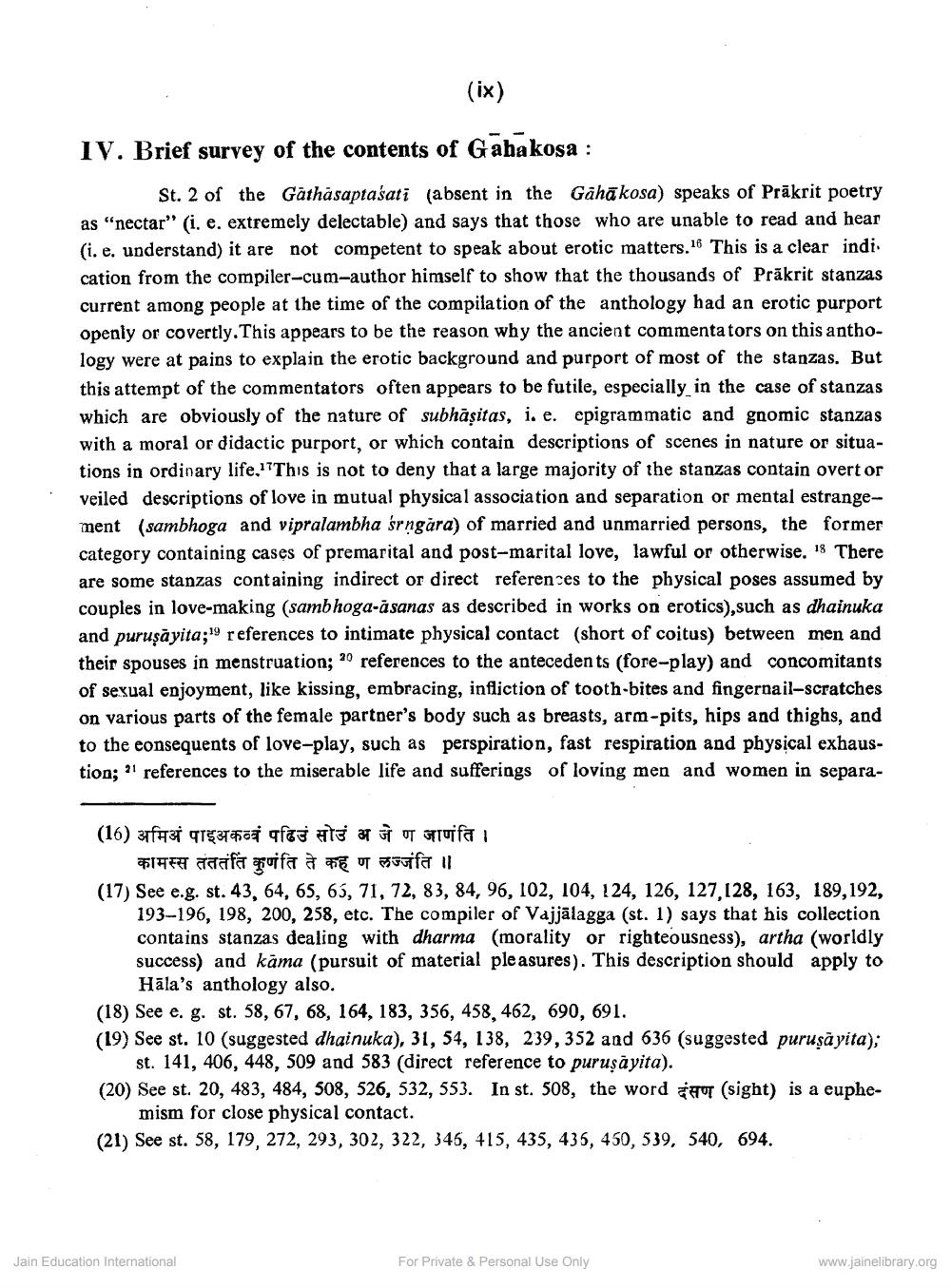________________
(ix)
IV. Brief survey of the contents of Gahakosa :
St. 2 of the Gathāsaptaśati (absent in the Gāhā kosa) speaks of Prākrit poetry as “nectar" (i. e. extremely delectable) and says that those who are unable to read and hear (i. e, understand) it are not competent to speak about erotic matters. 16 This is a clear indi. cation from the compiler-cum-author himself to show that the thousands of Prākrit stanzas current among people at the time of the compilation of the anthology had an erotic pur openly or covertly. This appears to be the reason why the ancient commentators on this anthology were at pains to explain the erotic background and purport of most of the stanzas. But this attempt of the commentators often appears to be futile, especially in the case of stanzas which are obviously of the nature of subhāṣitas, i.e. epigrammatic and gnomic stanzas with a moral or didactic purport, or which contain descriptions of scenes in nature or situations in ordinary life.1? This is not to deny that a large majority of the stanzas contain overtor veiled descriptions of love in mutual physical association and separation or mental estrangement (sambhoga and vipralambha śrngara) of married and unmarried persons, the former category containing cases of premarital and post-marital love, lawful or otherwise. 18 There are some stanzas containing indirect or direct references to the physical poses assumed by couples in love-making (sambhoga-āsanas as described in works on erotics), such as dhainuka and puruṣāyita;'references to intimate physical contact (short of coitus) between men and their spouses in menstruation; 20 references to the antecedents (fore-play) and concomitants of sexual enjoyment, like kissing, embracing, infliction of tooth-bites and fingernail-scratches on various parts of the female partner's body such as breasts, arm-pits, hips and thighs, and to the eonsequents of love-play, such as perspiration, fast respiration and physical exhaustion; ? references to the miserable life and sufferings of loving men and women in separa
(16) 3f43f 9153a faz 5 a BOT turfa
कामस्स तततंति कुणंति ते कह ण लज्जति ॥ (17) See e.g. st. 43, 64, 65, 65, 71, 72, 83, 84, 96, 102, 104, 124, 126, 127,128, 163, 189,192,
193–196, 198, 200, 258, etc. The compiler of Vajjālagga (st. 1) says that his collection contains stanzas dealing with dharma (morality or righteousness), artha (worldly success) and kama (pursuit of material pleasures). This description should apply to
Hāla's anthology also. (18) See e. g. st. 58, 67, 68, 164, 183, 356, 458, 462, 690, 691. (19) See st. 10 (suggested dhainuka), 31, 54, 138, 239, 352 and 636 (suggested purusāyita);
st. 141, 406, 448, 509 and 583 (direct reference to puruṣāyita). (20) See st. 20, 483, 484, 508, 526, 532, 553. In st. 508, the word dat (sight) is a euphe
mism for close physical contact. (21) See st. 58, 179, 272, 293, 302, 322, 345, 415, 435, 435, 450, 539, 540, 694.
Jain Education International
For Private & Personal Use Only
www.jainelibrary.org




